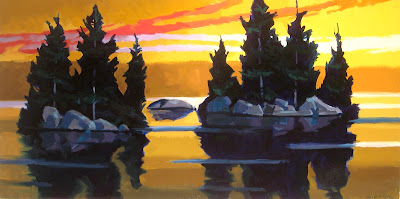Orchestrating an Exhibition or a Painting

If you are really small you might be able to tour the Delaware Art Museum's Centennial Juried Exhibition before it opens. You could crawl around this scale model of the show with all the works to be displayed reproduced in tiny versions on the walls of the Museum's gallery. The scale model of the show was arranged by Margaret Winslow, the Assistant Curator of Contemporary Art. Her crew had the model out to show them where to place the pieces as they arrived in the Museum earlier this week. I think it looks really cool. Here's my painting hanging on its trusty FoamCore wall below. (You can see a better image of it here ), After I delivered my painting to the Museum on Tuesday, I checked out painting studio where I've been invited to teach a landscape painting and drawing workshop on Oct. 21 with Saralyn Rosenfield. In addition to overseeing the Museum's studio classes, Saralyn helps by writing some of the educational material that ...




